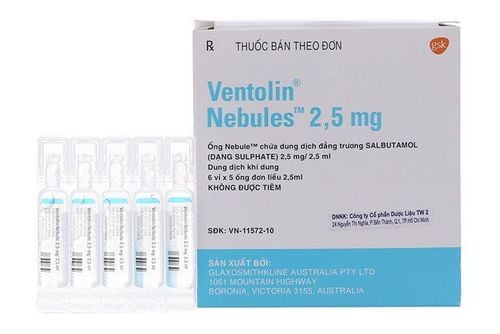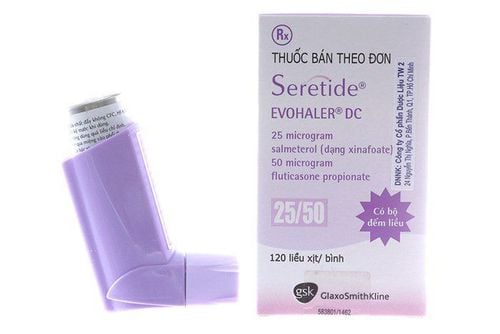This is an automatically translated article.
Postural draining vibration technique is used in the treatment of respiratory diseases to reduce sputum stagnation, increase the effectiveness of treatment of respiratory diseases, improve lung function, reduce complications, as well as improve lung function. like hospital stay.
1. What is postural drainage?
In the treatment of respiratory diseases, vibration combined with postural drainage is a technique of using hands to apply a mechanical force to the chest to vibrate the stagnant sputum in the lungs and airways, thereby helping the patient. cough, release sputum to the outside.
This technique is performed with the aim of increasing the effectiveness of treatment of respiratory diseases, improving lung function, reducing complications and length of hospital stay.
2. Indications and contraindications for postural drainage vibration technique
Postural drainage is indicated for respiratory diseases with bronchial empyema, including: lung abscess, pulmonary tuberculosis, chronic obstructive pulmonary disease, chronic bronchitis , bronchiectasis, infection after lung surgery, stroke patients lying for a long time have sputum sputum.
Contraindications to perform the technique of vibrating drainage in the case of patients with severe hemoptysis, uncontrolled respiratory pathology in patients with pulmonary infarction, pleural effusion (a large number of patients). ), pneumothorax, acute pulmonary edema, congestive heart failure; Cardiovascular instability due to myocardial infarction, hypertension, hypotension, arrhythmia or recent neurosurgery.

Kỹ thuật vỗ rung dẫn lưu tư thế được chỉ định cho người mắc bệnh lý hô hấp
3. How is the postural drainage technique performed?
The steps to perform the technique of vibrating drainage are as follows:
Step 1: Postural drainage - Depending on the position of the damaged lung that needs to be affected, place the patient in an appropriate drainage position. The principle of performing postural drainage is to ensure that the injured part of the lung needs to be released at a position higher than the trachea. Step 2: Clap - Perform the flapping movement by pinching the fingers to close, cupping the hand to form an air space in the palm, then patting evenly and continuously to apply mechanical force to the chest wall . Depending on the patient's condition and disease severity, the impact force will be different and will not cause pain to the patient. After each stroke, the technician instructs the patient how to cough to release the stagnation of phlegm. Step 3: Vibration - Perform vibration movements by placing both hands on the back chest wall of the patient, corresponding to the damaged lung. Ask the patient to inhale and hold the breath, when the patient exhales, the technician pushes the chest wall with his hand to create mechanical vibration to loosen the phlegm. At that time, the patient who coughs effectively will easily expel the sputum. Step 4: Abdominal breathing and sputum - Instruct the patient to breathe in the abdomen by taking a deep breath, holding the breath to keep the abdomen tight, then slowly exhale, keeping the abdomen following the breathing rhythm. Finally, the patient takes a deep breath to cough up the stagnant phlegm in the lungs. The patient cleans the mouth and nose area after coughing and spitting. Depending on the patient's condition, the time to perform the postural drainage technique can be short or long. The average time to perform this technique is from 15 to 30 minutes, done 3 times a day (in the morning, afternoon and evening). It is possible to instruct the patient's family to perform this technique at home, to help the patient loosen phlegm, cough and cough more easily.

Nên lưu ý khi thực hiện kỹ thuật vỗ rung dẫn lưu tư thế gì?
4. Notes when performing posture drainage technique
In the process of performing the technique of vibrating drainage, it should be noted:
Should be done before eating or 1-2 hours after eating to avoid making the patient vomit. Vibration should be patted in the chest area with the rib cage, patting the spine, shoulder blades, collarbone, stomach, and ribs to avoid injuring the patient. Vibration technique for postural drainage is an effective method to help restore the patient's respiratory function. However, in order to achieve high efficiency, the technician must have a thorough understanding of the profession and the patient must cooperate in the implementation process.
Vinmec International General Hospital is the address for examination, treatment and prevention of diseases. When performing the examination process at Vinmec, customers will be welcomed and used modern facilities and equipment along with perfect medical services under the guidance and advice of experts. Good doctors, well-trained both at home and abroad.
Please dial HOTLINE for more information or register for an appointment HERE. Download MyVinmec app to make appointments faster and to manage your bookings easily.













